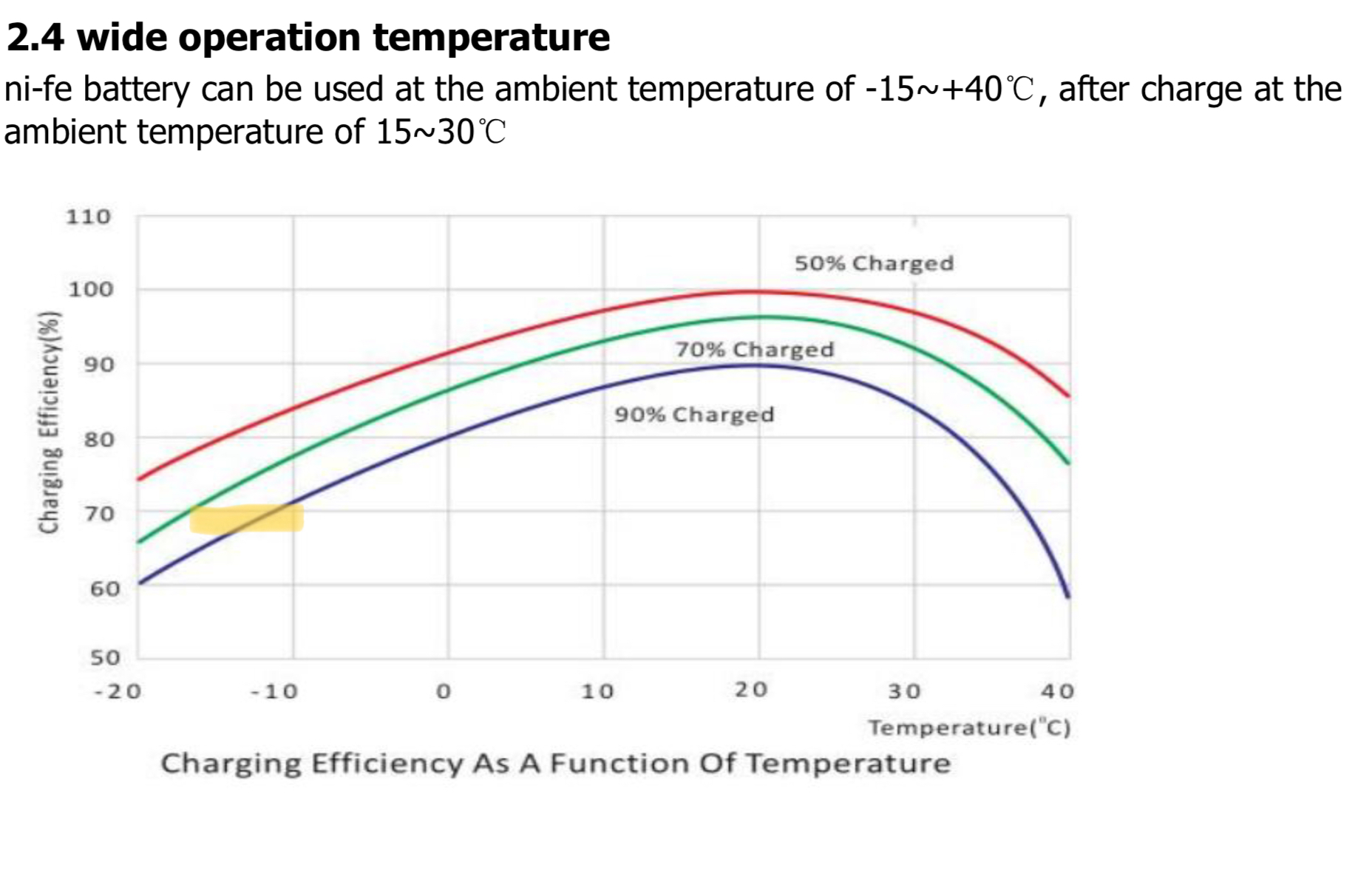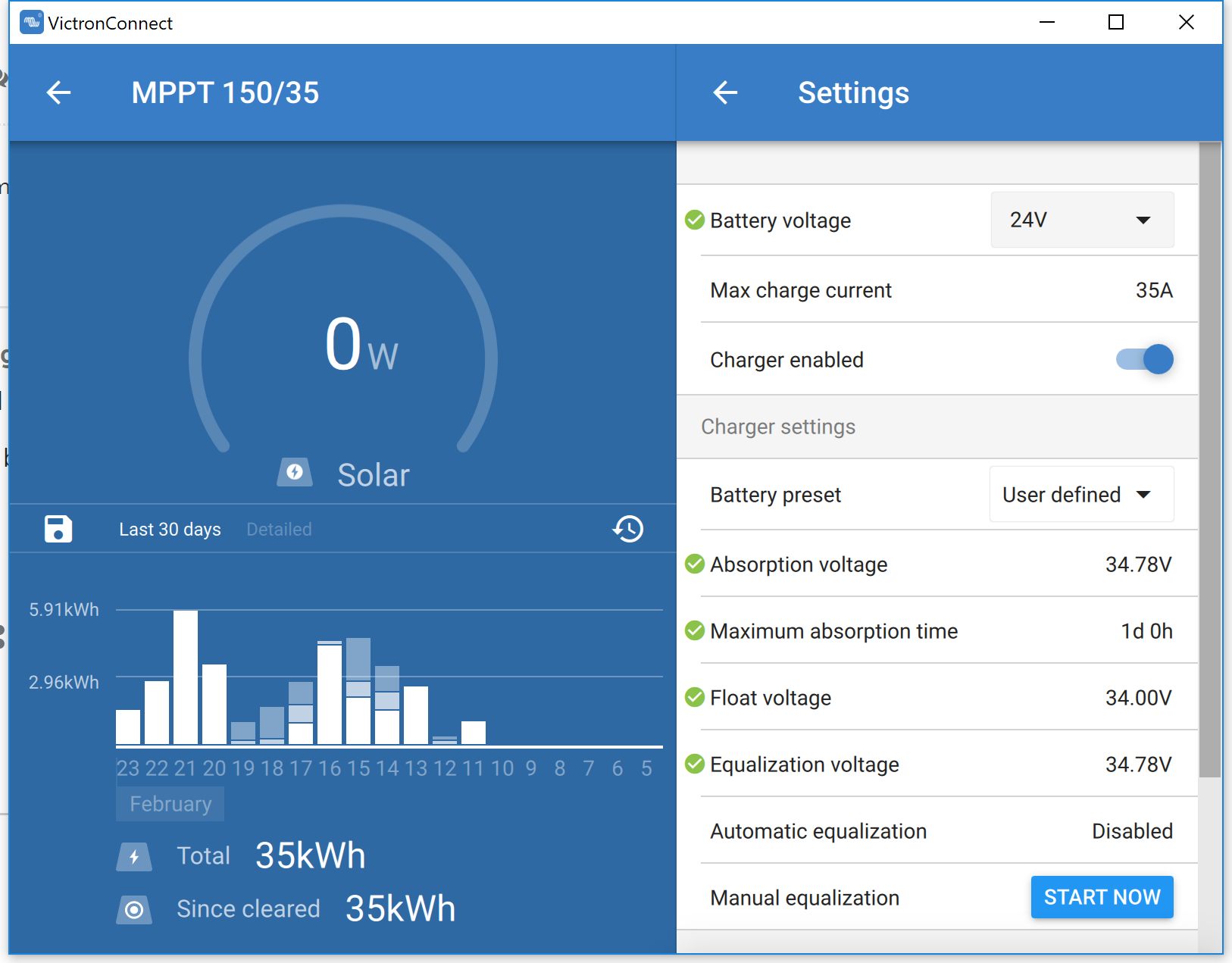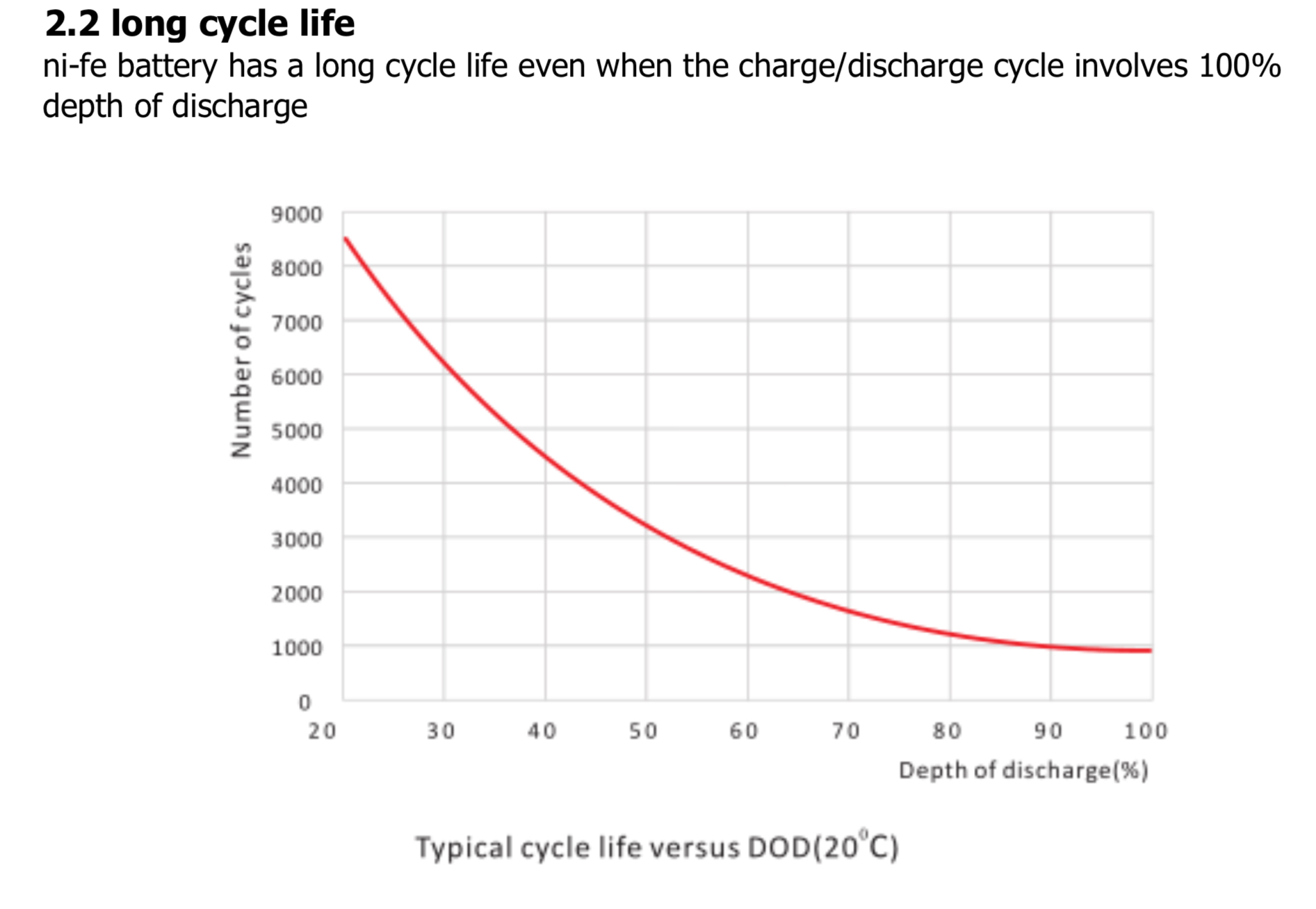I'm attracted to these batteries as a long term asset. Should I go DC coupled? AC coupled? Where can I find other users with nickel iron experience?
- Home
- Anonymous
- Sign in
- Create
- Spaces
- Grafana
- Node-Red
- Unsupported topics
- Questions & Answers
- Modifications
- Communauté francophone
- Deutschsprachiger Bereich
- Preguntas en Español
- Explore
- Topics
- Questions
- Ideas
- Articles
- Badges
what do you mean DC coupled AC coupled all batteries ad DC
NiFe referance you will just have to do some google searching, for this info as I dont know anyone using these, at the moment the best options are Lithium Phosphate or have a look at ultra capacitors as these maybe a up and coming option in a few years.
Why would you want to use NiFe batteries? what do you see as an advantage? They have some big downsides like low efficiency, high cost, wide voltage window, low power (charg / discharge), etc.
The advantages are that they are indestructible.
They cost more than some lithium ion batteries but here in Australia they cost less than victron lithium batteries.
Ok, well if you size them so that you don't exceed maximum charge / discharge current...
But you'll have to check if voltage range is compatible with Victron devices, and maybe there is a bms available for them? also if you need special charging curves that are not available you might have to improvise (or maybe a bms can take care of that)
20 x NiFe cells in series should be bulk charged to 33v with an absorption time of about 5hrs. They are exhausted at 22v and LVCO is 21.9v
Optimum charging is C/4 up to c/2. Higher rates of charge and discharge are tolerated for short periods and the battery is insensitive to over or under charging.
The main drawback is maintenance. Regular topping up with distilled water.
They have a proven service life of over 50 years and infinite shelf life with careful storage.
Then you'll have to go for 19 in series, as the Victron inverter/chargers go up to 32 V
'service life' probably in back-up use, not cyclic use.
That is no problem, I think it can go down to 18 volt (though in ESS systems it stops discharging at about 21 volt)
So I think it's safe to say that AC coupled is not really an option since the MultiPlus charger is not compatible. DC coupling seems possible without using a charge controller at all.
They are used in electric locomotives where they outlast most of the other components. The float voltage is 29v
It is unlikely that I would ever want to charge them with the MultiPlus charger.
More interesting is the inverter's maximum tolerated voltage and whether LVCO can be set low enough.
do you have a link to datasheets of NiFe cells that are suitable for cyclic use? Might be interesting then.
I can only find charge / discharge information, no information on cycle life (or I'm not looking hard enough)
What I did find is a -terrible- efficiency... worse then lead-acid!
Can you point me to cycle life information?

From the NiFe sales brochure of:
Ah there's something, good numbers:
Cycle Life 11,000 Cycles At 80% Depth Of Discharge
Ah yes....but they don't give any warranty on the cycle life...
There is so much BS regarding these batteries that wading through it all requires a strong stomach and a lot of spare time
That's why I remain skeptical, I now they're supposed to do great in float-applications...but this 11000 cycles is the only number I could find...and they don't give any warranty on it.
In the modern economic environment most corporate structures don't last long enough to offer that sort of warranty. The company is long gone while the product is still chugging along.
Maybe , but the product has not taken off in the market place, were the LP version has and its now quite well known and they have great outputs and charge rates , so the its upto you what you select.
NOW the new one on the block though is Ultra Capacitors now 1,000,000 is impressive cycle life
but as far as I can find out the LPs have great life as well
ie and I maybe wrong here but at 80% DOD
after 2000 cycles the LP drop to 80% of original output
after 5000 cycles the LP drop to 70% of original output
after 10,000 cycles the LP drop to 60% of original output
after 50,000 cycles the LP drop to 50% of original output
I don't have a 250/100 at hand, but checked with the 150/35 for you, maximum I can set it is 34,78V (so 20 cells might work? - if inverter can handle it)
Couple years ago I was considering those cells for my solar and backup application.
The main reason was the longevity.
When I looked closely at the process of changing electrolyte in them, I changed my mind.
Lets assume you have 48v/200Ah NiFe battery pack, and you have to change electrolyte because you want them to be new again.
Can you imagine yourself lifting, one by one, 40 cells (200Ah cell weighs over 15kG) turning them over to drain the old electrolyte and than flush the cell with water, drain it and finally fill them with new electrolyte?
The next problem is gassing. They generate hydrogen so you cannot put them anywhere you like.
The next problem is the efficiency of this cell. 60-70% is not much.
For off-grid system somewhere in the woods where there is no grid, the efficiency may not matter, but if the grid is available and you are using ESS system it is a different "ball game".
In some countries, like mine, you can store your summer excess solar energy in the grid and use it within a year with the 20% loss. For me, grid is a "battery" with a 80% efficiency and it is free to install if you have grid connected to your house.
Replacing it with the battery with 60-70% efficiency, and paying for it, makes no economical sense.
Now even their longevity is not the advantage anymore.
If you want longevity buy LTO battery and your grand kids will keep enjoing them. :)
Paul B,
Perhaps he was referring to the way the inverter is setup.
A DC coupled inverter has a much higher than 90% efficiency; however, an AC coupled inverter will have a lower efficiency since the DC energy coming from the solar panels are converted by the inverter connected to the solar panels into AC electricity, and then a second inverter converts the AC electricity to DC to charge the batteries.
Since NiFe batteries have lower efficiency than Lithium batteries, a significant proportion of energy would be lost this way.
If on the other hand there is only one inverter (DC coupled) or charger connected to the batteries there are less losses due to less energy conversions.
This is a cost comparison per kWh of a Powerwall and a NiFe battery. No inflation or cost changes are included.
The cost of PV, wind, hydroelectric, or grid electricity would need to be tied to this to obtain a more accurate estimate of the cost of producing, purchasing, or / and storing energy.
For those of you unfamiliar with NIFe batteries, I thought of sharing a couple of videos of two people who use them on a daily basis. Each of these video authors has several more videos on the same subject.
One of these authors lives off grid full time with all the modern appliances and an electric vehicle. The second author disconnects from the grid every night.
Buyer beware: NiFe batteries will be appropriate in some but not all instances.
A feasibility and a suitability analysis may be warranted.
I am not trying to dissuade you from buying NiFe battery. I can see your decision is made.
I am just trying to provide different point of view.
Powerwall is not the only alternative to NiFe.
Maybe add to your comparison other chemistries.
LiFePo4, LiFeYPO4, LTO, NMC.
You will see that the NiFe will not look so good when compared to them.
In your table the self discharge rate is missing. NiFe is not a champion in this regard.
Maybe add to it the cost of the work needed (water adding) to keep NiFe batteries running and the cost of the place where you will be able safely keep them (hydrogen explosion risk) and also the size of it (the sq. meter of any building has its price).
As you mentioned, the cost of energy put into the battery should be taken into account because from NiFe battery you will only get 60% of it back, and only if you take it out quick because self discharge will "eat" additional energy.
The process of changing the electrolyte is not simple, and it is the only reason those cells can be considered long living.
I watched both films, you posted links to.
In first we learned that NiFe are perfect, but no real data to prove it.
In second there is very in depth comparison of couple chemistries, but the application is a totally off-grid system.
I noticed one funny thing.
The author said that he, some time ago, bought NiFe batteries from Hungary.
Why he is not using them anymore, and he replaced them with ones from China.
What happened to those long-lived (eternal) batteries bought from Hungary?
EDIT:
I looked at PowerWall 2 specs and they are different from what you are showing in your table.

Efficiency is 96%
You forgot to mention that PowerWall 2 has a build in inverter/charger and this 90% is the round trip efficiency (AC to DC to AC).
So your table is not accurate.
Hello! New to the forum, I just stumbled on the NiFe topic.
I have been living for 4 years with them now. Fully off-grid powering a large modern home entirely electric (HW, and cooking included). Off grid both by choice and... because in remote Australia you don't have a choice :)
So, summary of practical experience.
NiFe here are not a lot more expensive that other chemistries. So that's not a huge factor.
They are meant to last longer but after 4 years... I just don't know, honestly. Give me another 6. At the time I bought them there were no source I coud find here so I bought them from China. Not sure if it makes a difference in quality and therefore longevity.
My objective in buying them was longevity, yes but also robustness. I didn't want to worry about undercharging or overcharging. Again, a bit early to tell, but they are still alive despite some heavy cycling, and two total discharges. (#!@#$#@ inverter not behaving).
Refilling with water to be honest is a PITA. It's only 1 or 2 hours of work every 2 or three months - so not really much in the scheme of things, but just another maintenance job you'd rather not have to do... cost is nothing though. about 30-40l every 2-3 months. Now my batteries are especially hard to refill (china?). For example the shell is not transparent so hard to see where the level is at. So wjhilst refilling is not a huge deal, they are NOT fire and forget.
Charger/inverter settings. BIG DEAL ! I overlooked this one at the start, but it's very important. LVCO should be able to be set as low as 30V. (for a 48V ssytem) The internal resistance means that voltage will drop scaringly even on a 50% state of charge. If you inverter decides to stop playing, that is very annoying, basically leaves you with a whole lot of capacity you cannot tap into. Max charging voltage is another important one - you need to go up to 66-67V to charge them at max speed (but then that's a lot of amps so the charger need to be able to handle it)
Self discharge is not really a problem for solar application, they don't stay idle long enough ...
Efficiency is not really a problem either, as one of the other answers say panels are cheap enough these days to design for it.
So if I had to buy them again, I probably would IF they prove to have the longevity they claim. But in hindsight: a) I'd be choosing chargers and inverters that allow me to take full advantage of them - and to be frank the brand I have is utterly cr*p for this and other reasons. b) I'd pick a design easier to refill with water
Thank you for this real life report on those cells.
As I suspected they are good choice for total off-grid use.
The longevity is probably no longer their best advantage because LTO cells are probably as good in this regard and they have other important advantages over NiFe.
Their greatest advantage is that they are "idiot proof" or a disaster proof.
Automatic water replenishing systems are possible.
There is a NiFe maker in Ukraine that sells such an option for their cells.
I have seen something about that also from China's manufacturer of NiFe cells.
Related Resources
Additional resources still need to be added for this topic
question details
9 People are following this question.

